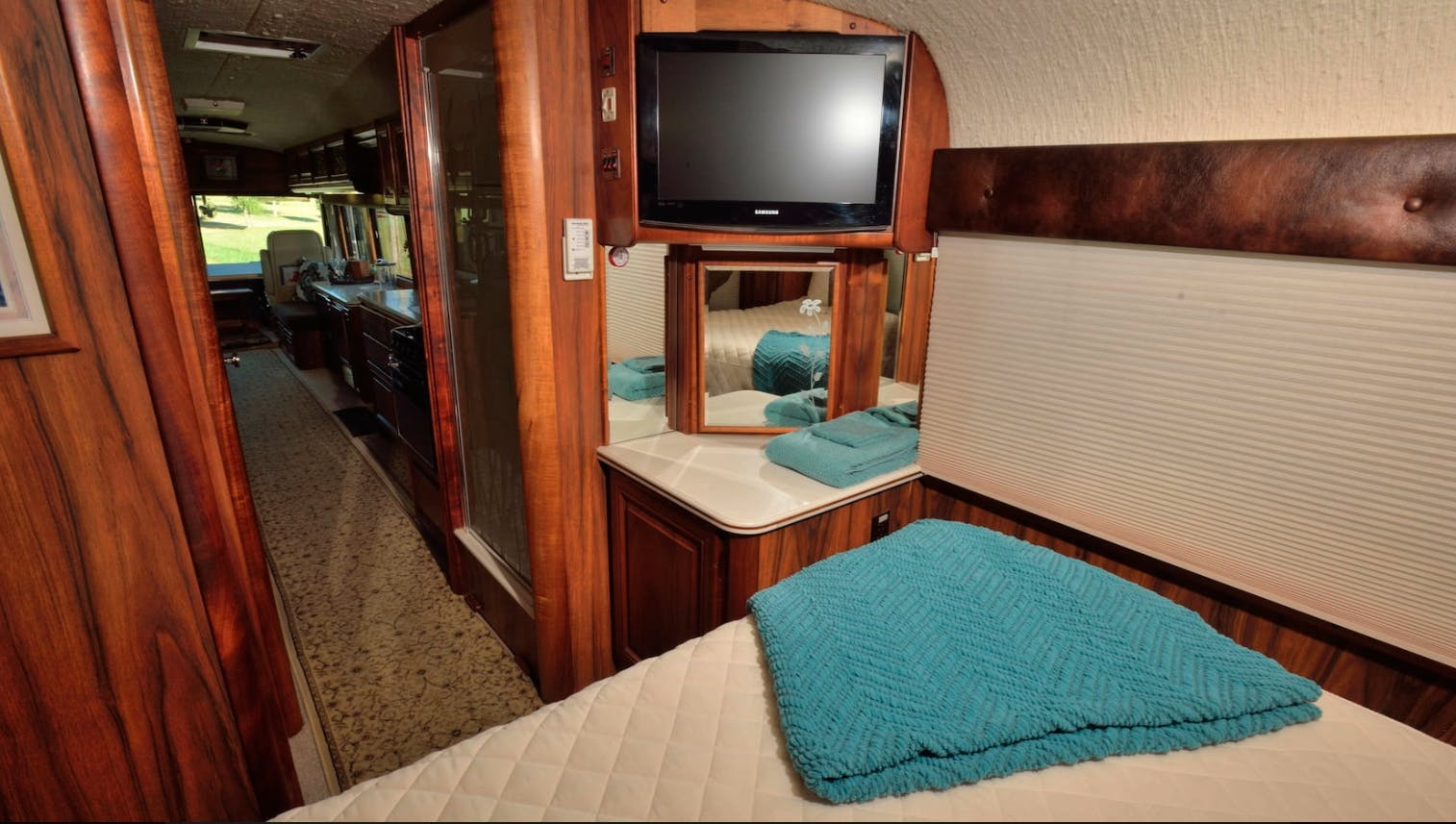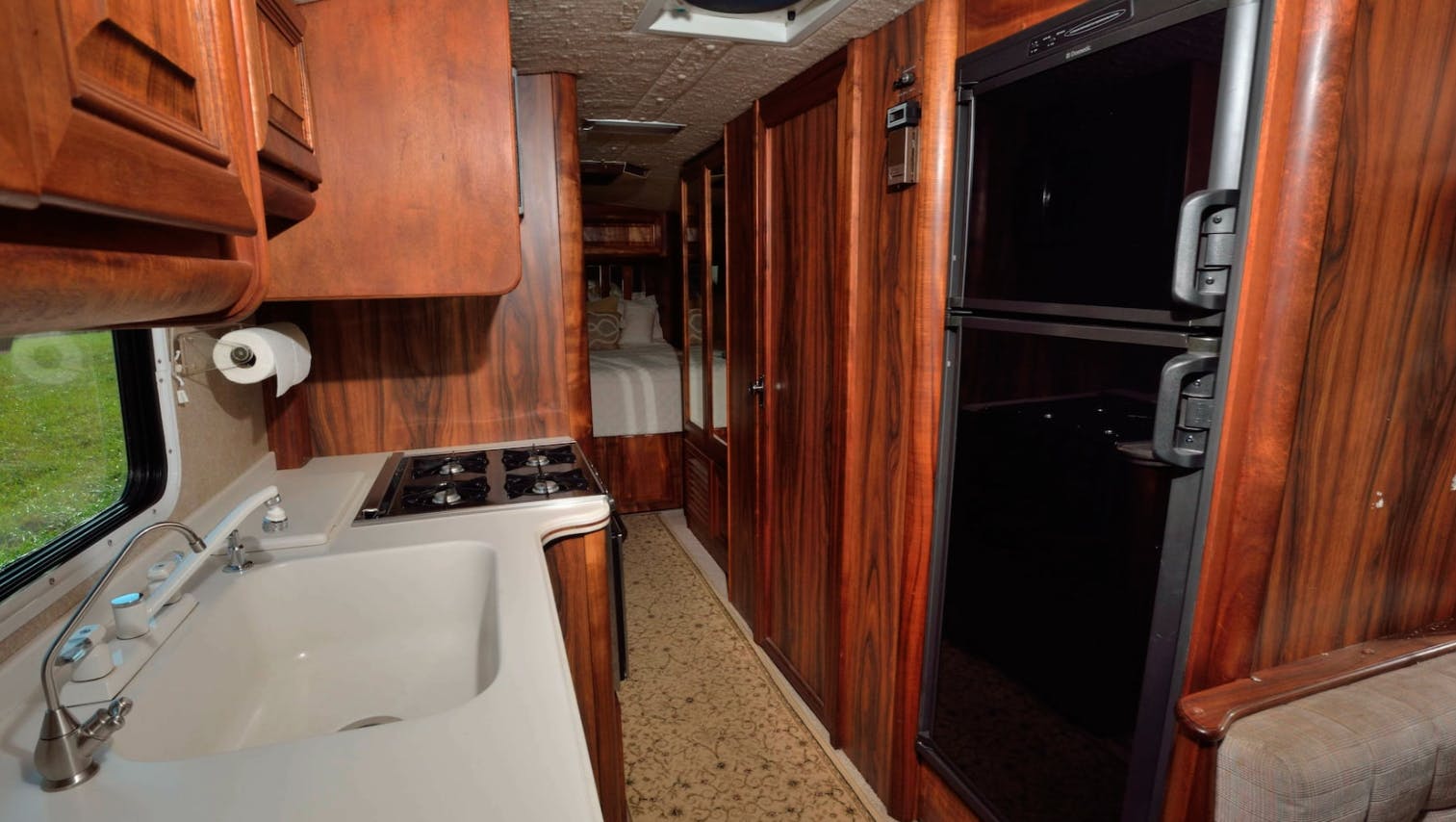Retro RVs from Ford and Chevy go to great lengths for your attention
What’s old is new again. Both the vanlife movement and maker culture have done a fantastic job of spreading awareness of (and demand for) recreational vehicles (RVs).
With these specialized forms of transport comes a rejuvenation in the skilled trades that keep those big wheels a-rollin’. Whether it’s plumbing, electrical, woodworking, or interior design, trades that many of us feared would disappear forever have indeed persisted.
RVs are hot once more, but does that mean museum-quality examples of these specialized vehicles can fetch big bucks?
We may have an answer rather soon. We recently came across two such examples from decades past, and both are bound for the auction block: a 1965 GMC custom motorhome headed to Mecum’s Kissimmee sale in mid-January, and a 1974 Ford C-750 cabover with a Camelot trailer that’s currently up for bidding on Bring a Trailer.
Apples-to-oranges comparisons have little weight with actual buyers with actual needs, but if you’re theoretically looking for an RV that puts your average Class A rig to shame, both examples make a compelling argument.
Which company did all-out RV better, and which motorhome will fetch more money when the auctions end?
Yes, we put Chevy in the title, and yes, this is a GMC bus. But a Ford vs. Chevy rivalry could and should extend into the rarified air of bespoke, vintage motorhomes currently on the market. And Chevy GMC fans can rejoice, as their entry is arguably a much better-engineered solution. It’s almost a level-headed answer to a question that nobody asked.
Well, almost nobody, as the seller reportedly saved a discarded Army passenger bus from a certain death with the vision of making an “absolutely peerless motorhome, a bespoke coach unlike any other ever conceived.”
Indeed, the wood (i.e., not particle board) cabinetry appears to be of the high-grade variety, while electronic upgrades range from aircraft-grade wiring to Bose audio, solar charging, and two flatscreen televisions. The owner turned the bus into a proper RV complete with a wet bar, stove, fridge, ice maker, air conditioning system, insulated Peninsula side glass, and even a central vacuuming system.
Clearly this isn’t some hack job, bargain-basement Class A motorhome, but there’s so much more to this ex-Army GMC product.
That’s because the owner also installed a thoroughly modern Cummins diesel ISL engine weighing in at a robust 8.9 liters. An Allison six-speed automatic transmission is likely just as important to the enhanced performance of this restomod GMC bus, while a full restoration of the rest of the drivetrain, suspension, chassis, brakes, and steering brings the rest of the driving experience back up to snuff. Rolling stock comes from Alcoa wheels with Michelin rubber, and the seller acquired a host of receipts over the course of 50,000 miles of use.
To say this GMC motorhome is the best of old and new is an understatement. While the later GMC motorhome was indeed a front-wheel-drive wonder, that creation still used a thirsty gasoline engine without the benefit of an overdrive gearbox. BaT’s is clearly the GMC to have if you’re gonna put down the miles and care about every dollar spent while ramblin’ about the country.
That’s the “Chevy” in our little retro RV comparo. What about the Ford?
This one lacks the subtlety of a restomodded powertrain or other technological upgrades. The cabover Ford C-series was intended for tractor use in a tractor-trailer combo, and even the uninitiated among us might recall it from TV and movie appearances of the era (most notably on TV shows like CHiPs). The Ford C-750 is not a comfortable bus; it’s likely more of a penalty box at higher speeds and longer distances because of the limitations of a “cab over” passenger compartment.
And there’s no free flow between the C-750 truck and the enclosed “Camelot Cruiser” trailer behind it, as passengers must go outside to switch between spaces. But what happens when you leave the cramped cab, hopping off the purely vintage, FE-derived 391-cubic-inch V-8 under the floorboards?
What awaits you is a similarly vintage experience within a Gerstenslager trailer, fully kitted out by Edler & Company to become the aforementioned rolling tribute to Camelot. The degree of preservation is what makes this combo special, as this motorhome is anything but a restomod.
The “1970s Colonial Revival” interior present in the Camelot Cruiser is almost too magnificent to process. You got the dark wood pillars and Colonial throwback cabinets/furniture, all underpinned by proper avocado green carpeting. While the two matching snowmobiles seem a bit out of place for large swaths of the American countryside, and while design types love to rattle on and on about the more popular midcentury modernism, the appeal of a rolling tribute to Colonial Revival can’t be understated. Ditch the snowmobile storage for a conversation pit, and you’d have the most 1970s thing to ever grace the highways.
More to the point, as previously discussed in the EMC Starfire article, the 1970s was a golden era of the motorhome industry, just as the 1950s diner scene was for Chevrolet and the Tri-Five. But ’70s RVs were (and still are) normally crafted on an integrated body, not assembled in tractor-trailer fashion; finding a parking spot for this Ford might be challenging. And rest stops will be needed, after all those hours behind the wheel of a vintage cabover truck. Not to mention the size of the fuel bill relative to the modern powerplant in the GMC.
Picking a winner in this battle is easy if you don’t care about fuel bills and parking, as the Ford tractor/trailer is simply stunning. I’d never drive it outside of an interstate highway ... but I digress.
Let’s answer our initial question: You better believe that museum-quality examples of the breed can fetch big bucks. Case in point: this Ford sold for $42,000 last year. At the time of writing, bidding for the Ford combo has already reached $120,000 with 5 days left. Wow.
Even with an impressive list of repairs (mostly fuel system and suspension refreshing) performed by the current owner, this is likely to be a helluva return on investment when the auction ends. And considering the price of this Ford and front-wheel-drive GMCs that went to market before it, there’s little doubt that the Cummins-powered GMC bus will net a similarly high hammer price.
And yes, these asking prices could probably get you a superior Class A motorhome if you shopped instead on the modern RV marketplace, but it’s clear that some could care less about modern motoring. Retro RV–ing is clearly a thing, and personally, we’re here for it.
Only one question remains: Is a perfectly preserved Ford tractor trailer or a restomod GMC Army Bus the right retro motorhome for your needs?
Check out the Hagerty Media homepage so you don’t miss a single story, or better yet, bookmark it.






































Both give you a place to sit and wait for roadside assistance.
the Camelot Cruiser has deployable snowmobiles!
Hmmm, as if anyone would pilot that rig to anywhere there was snow on the road?
The GMC is a restomod, might as well get a modern model. The Ford is cool but how do you take a family/friends along, unless the states you plan to use it in allow passengers to ride in the trailer. Oh well some seem to like the idea. Cool to look at though.
You’ll need a class A lic for the Ford
I can appreciate a theme but that’s just too much snot green for me
Oh boy! That awesome GMC Motorhome is a definite beauty! That favors comfort and economy, especially over that cab over nightmare bone shaker! See I know exactly what I’m talking about, with well ver 400,000 logged miles in a number of those awful Ford trucks designated C750. I was a truck driver for a nation wide LTL trucking company called RoadWay, that has what might be the largest fleet of C750’s, in straight box trucks, to tractor trailers with trailers from 28’ pups to 53’ dry boxes. I worked out of their Lincoln, R.I. barn, all through 1982-1992, driving all types, from gas powered to Cat diesel, all with 5 speed transmission and 2speed rear ends. None with power steering, or any creature comforts except decent ventilation, but you were sitting right on top of a huge V8 gas or diesel engine and radiator! Riding just in front of the front axle. The older trucks had so much slop and play in the shifters if you weren’t careful you would rap you knuckles on the steel dashboard shifting into 1st, 3rd or 5th gears. Or in a newer one the shift and steering was so tight that your arms would be sore after a day of peddle freight. NO! That’s not what I would call a delightful retirement RV, in the least! I remember burning around 80-150 gallons of gas in one day of local freight peddling, over just 50-100 miles, all within Rhode Island. One load of paper rolls, that weighted 40,000 lbs, in a 48’ trailer, that was only 28 miles from its destination, burned just over 40 gallons round trip! That’s was like 2 GALLONS to the mile going and 3 mpg on the return! Slamming gears, pedal to the metal all the way, fought a two mile uphill on the way trying to maintain 40 mph in a 55 zone with the flashers on and the big 478/4 brl dual exhaust V8 screaming between 3hi and low. But those big dumb engines were bulletproof and never failed! Or burned much oil.
I will take the Ford because I want to get to where I going.